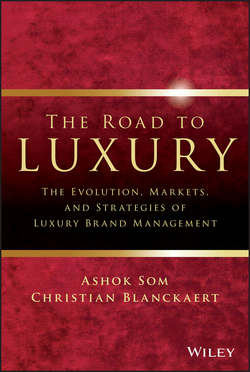Читать книгу The Road To Luxury - Blanckaert Christian - Страница 8
На сайте Литреса книга снята с продажи.
Chapter 1
Introduction
Definition and Crisis of Luxury
Issues of Defining Luxury
ОглавлениеIt is important to understand why certain brands are called luxury brands and what justifies the superior positioning they command. Luxury empires are not built by selling tasteful products at an exorbitant price. Luxury brands have been carefully crafted through meticulous strategies in marketing and brand building, making their mark in the consumer's subconscious and having the following main characteristics: brand strength, differentiation, exclusivity, innovation, product craftsmanship and precision, premium pricing, and high quality.
It is the differentiated quality of the material, design, and performance of a Patek Philippe watch that merits a 1,000-percent premium over a normal watch picked up from a general store. It is the craftsmanship that goes into the Kelly bag made by Hermès that justifies its exceptionally high price tag. It is only the brand strength of Louis Vuitton that can entice customers to preorder bags months in advance. It is attention to craftsmanship and nuances of details that help differentiate a luxury product.
Many misconceptions exist that surround the luxury industry: (1) Do luxury and fashion mean the same thing? (2) Does a high price imply a luxury product? and (3) Does luxury imply perfection?
Luxury and fashion do not mean the same thing; they can coexist, but that's not always the case. Until the nineteenth century, only the very privileged few could afford to keep up with changing trends. So only those who could bear the cost of luxury could afford to make and follow fashion. However, the twenty-first century consumer doesn't need to be wealthy to be fashionable; being trendy no longer needs to be costly. For example, streetwear brands produced by H&M and Zara are fashionable and affordable. Haute couture is still the trendsetter but is not the only reference anymore. Luxury products used to be seen as investments, which are not replaced that often, but now they have become more of a lifestyle choice. Many luxury houses try to release fashionable products along with their traditional luxury goods. For instance, Chanel offers fashionable products in order to keep up with the times and renew interest in their classic items.
If one pays a high price for an item, that does not mean that the product is a luxury good. Everyday products could trade up and charge a higher price. All luxury products are expensive, but not all expensive products are luxurious. This means that it is difficult to sell premium products as luxury goods – a phenomenon known as “premiumization” or “trading-up.” Similarly, it is unwise to reposition a luxury brand as a premium product to extend its market. Automobile companies have tried to reposition products both ways and have failed, such as Mercedes with both the launch of the Smart car and its acquisition of Chrysler. It had to launch Maybach. In the meantime, BMW traded-up to the 6 and 7 series together with trading-down to the BMW 1-series. Toyota and Nissan, on the other hand, launched the Lexus and the Infiniti from the very beginning. Porsche gained a significant market share with the launch of Cayenne in 2002, but in the meantime it suffered a lot of complaints from its loyal customers about the degrading of the brand image. When one pays a tidy sum to procure a luxury brand, what does he or she pay for? Perfection? Not necessarily. In some ways, what defines the luxury brands are the creators and not the consumers. A luxurious product may thus be far from perfect. However, would these characteristics be questioned in times of a recession, when consumers become more cautious, have a limited budget, and spend less?
